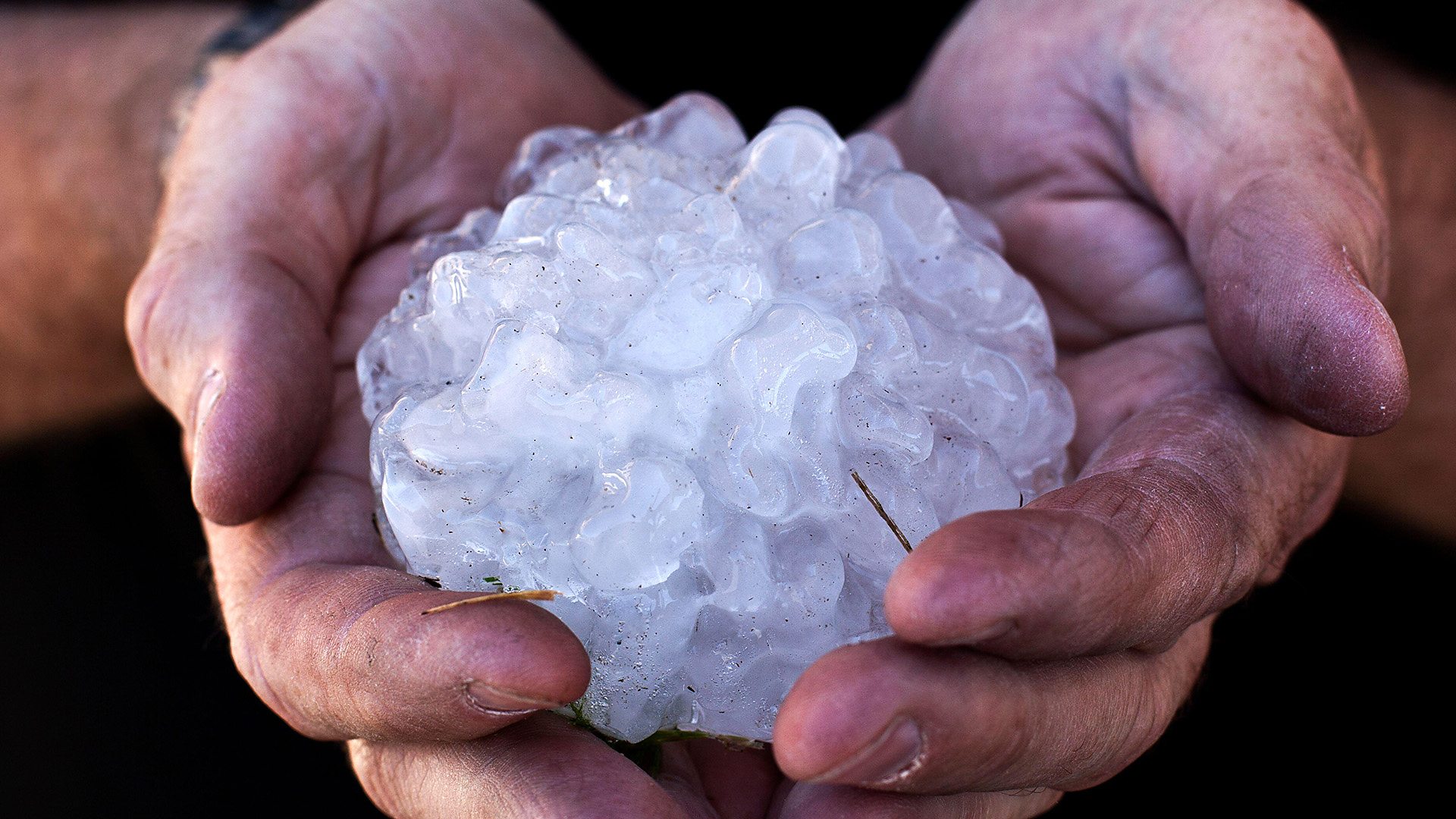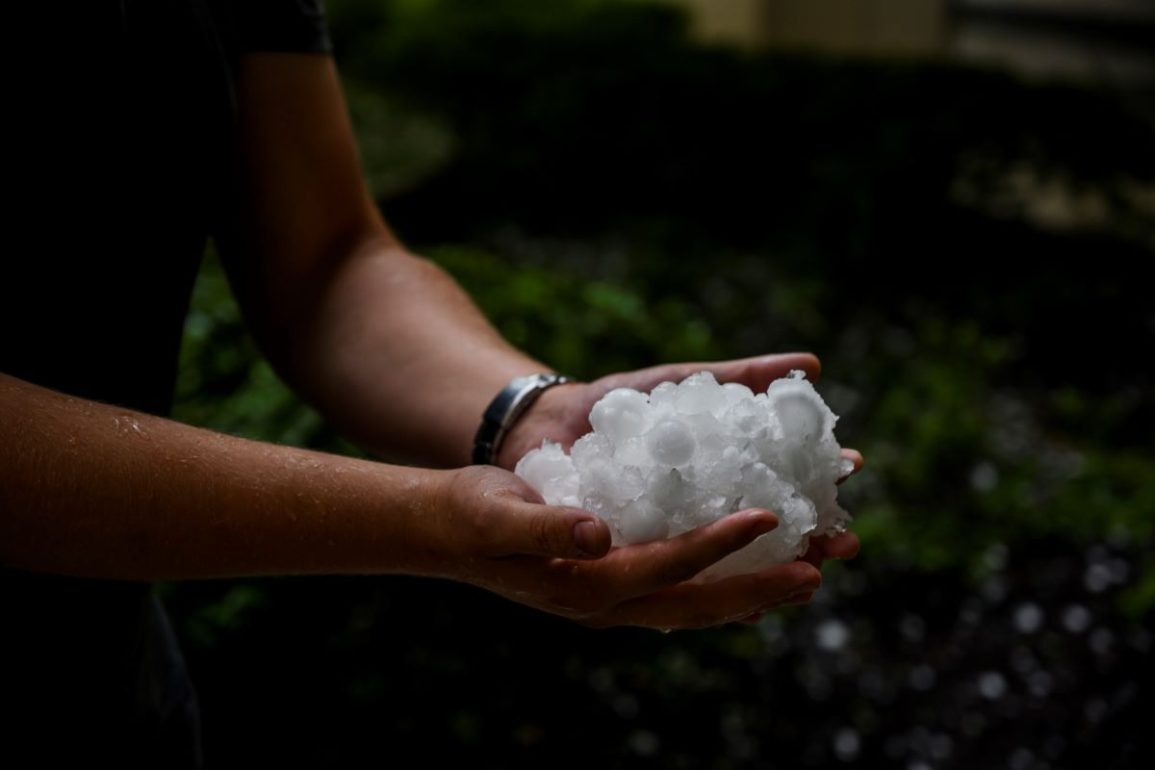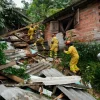The sudden, sharp crack startled Barb Berlin as she stood in the garage of her farmhouse near Inman, Nebraska. “I thought it was a gunshot,” she said.
Then she saw a flash of white and realized it wasn’t gunfire but hail.
A fist-sized hailstone had slammed into the tin roof of Berlin’s garage. Soon, others were pelting the hood of her Ford Mustang, parked outside, leaving craters the size of softballs.
“It was so loud and terrifying. I did a lot of praying,” Berlin recalled, expressing concern for her livestock. “I’ve never experienced hail like that before.”
Hail is a deceptive hazard. Amid a spring and summer filled with extreme weather, hail—not hurricanes, floods, or tornadoes—has caused the highest damage costs in the U.S. this year, according to Gallagher Re, a global reinsurance firm that tracks such data.
Research indicates that large hailstones, like those Berlin witnessed, will become more common as the Earth warms. A study published last month found that while smaller, less-damaging hailstones may decrease in frequency, the occurrence of larger hailstones is projected to rise.
The study, conducted by Northern Illinois University researchers, estimates that the frequency of hailstones 1½ inches or larger could increase by 15% to 75%, depending on the amount of greenhouse gas emissions humans produce.
Hail forms when thunderstorms push raindrops into the upper atmosphere. Typically, hail develops in areas where temperatures range between minus 22 degrees and 14 degrees Fahrenheit.
Climate change affects hail formation by providing more energy for upward air currents in thunderstorms.
“We expect stronger updrafts in the future due to increased atmospheric instability,” said Victor Gensini, a meteorology professor at Northern Illinois University and lead author of the study.
These intense updrafts allow hailstones to stay longer in parts of storms that favor hail formation, causing them to accumulate more ice before they become too heavy and fall to the ground, the study explains.
Gensini likened the process to using a hair dryer to suspend a ping pong ball in the air. “Now imagine trying to balance a baseball or a grapefruit. You’d need a much stronger updraft to counter the downward force,” he said.
The prospect of larger hailstones, which are already among the costliest weather hazards in the U.S., will exacerbate existing challenges, including rising insurance premiums.
“Thunderstorm-related losses are a major factor driving up insurance costs and prompting a reassessment of risk by not just the insurance industry but also banks and the federal government,” said Steve Bowen, chief science officer for Gallagher Re.

Hail alone accounts for 50% to 80% of thunderstorm-related insurance claims, Bowen added. So far this year, thunderstorms in the U.S. have caused approximately $61 billion in economic losses, with hail likely responsible for $31 billion to $49 billion of that total. By comparison, tropical storms and flooding combined have caused $14 billion in losses over the same period.
Although the dynamics of hailstorms are complex and difficult to study, advances in climate and weather modeling now allow scientists to simulate thunderstorms and analyze their microphysics, including hail size.
For their research, Gensini and his colleagues used future climate projections and incorporated them into a weather model similar to those used by TV forecasters.
The study predicts fewer days of hail in the Plains states but more frequent severe hail events, with larger hailstones also occurring in other regions.
While a warmer atmosphere could lead to more melting as hail falls, this primarily affects smaller hailstones, which fall more slowly.
Larger hailstones, like those the size of baseballs, can fall at speeds of about 100 mph, according to Harold Brooks, a senior research scientist at the National Oceanic and Atmospheric Administration’s National Severe Storms Laboratory, who was not involved in the study. By contrast, a 1-inch hailstone falls at 20 to 30 mph.
Brooks noted that the study’s findings align with previous research. A 2017 study used a different modeling approach and also predicted larger hailstones, though fewer hail days.
Additionally, Italian researchers who examined over a million hailstone dents from 1988 to 2016 suggested that storms were producing fewer but larger hailstones.
“The physical mechanisms being discussed here aren’t particularly surprising,” Brooks said. “We’ve seen hints of this in previous observations.”
Despite hail causing more financial damage on average than tornadoes, research into hail had stalled until recent advances in radar and weather modeling. “Tornadoes just seem to get more attention,” Brooks remarked.
He added that there are still important questions about hail that need answers: “Can we learn enough about how hail forms and about the distribution of hail sizes during a storm to make actionable forecasts several hours in advance?”
Next year, Gensini and scientists from other institutions plan to conduct the first U.S. field study of hail since the 1970s. The researchers will chase hailstorms, much like tornado chasers, and use mobile Doppler radars and other instruments to study the storms’ inner workings.
After Monday’s storm in Nebraska, Berlin noticed numerous roofing company trucks arriving in town. An insurance adjuster had already inspected her roof. Her Mustang sustained about $3,500 in damage.
If she had received more warning, Berlin said she would have moved her livestock to safety and parked her car in the garage. Unfortunately, no hail warning appeared in her forecast, and she only received an alert from her weather app after the storm had passed.
Thankfully, Berlin reported, “None of the livestock was hurt, but the hail was big enough to cause serious damage.”

